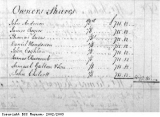Profit and loss
The point of the slave trade was to make a profit for the various investors. These were merchants, small traders, manufacturers, agents and plantation owners. The enslaved Africans were not thought of as people, only as saleable items that could be sold for profit. Most of the Bristol voyages (2,108 between 1698 and 1807) completed the voyage safely and profitably. As the Bristol merchant John Cary wrote in his book A Discourse on Trade, published in 1745, the slave trade held “… the Prospect of so great a Profit” to investors. In the early 18th century, profits of 50 to 100% were possible. By 1780, this was down to about 9%, but enough to be worth the risk of investing.
The slave ship the Joseph and Anna, owned by Abraham Hooke and Company, of Bristol, sailed on 3rd July 1723, for West Africa. She brought 260 Africans to the Caribbean island of Montserrat in February 1724, to be sold by Nathaniel Webb, one of the investors in the voyage. It was reported that the ship had made a “golden voyage which hath very much enrichen’d the former owners.”
Many disasters could affect a ship – sickness, war, slave rebellion, the weather, bad seamanship. The slave ship the Bristol, for example, in 1758 was taken as a prize by the French during a war with the Bristish. Its owners William Clymer & Co lost the ship and the 245 Africans on board. Another ship, the Phoenix, owned by John Anderson & Co, sank off the coast of Calabar (now Nigeria, West Africa) in 1782. The captain, 21 of the crew and 430 slaves were drowned.
This picture shows a page taken from the accounts book of the slave ship the Africa for a slaving voyage made in 1774. It shows the final sum paid out to the eight owners of the ship. The sum would have been received at the end of the voyage. The eight owners had equal shares in the slaving voyage, and each received £670 (about £33,500 today). They had each put in £711 (about £35,550 today). The ship cost them about £1,247 (about £62,000 today) to begin with, including the costs for fitting her out for the voyage (the ‘outset’ costs). Investors in such a slaving voyage would have been established merchants in Bristol such as James Rogers and John Anderson, and traders from outside of the city, such as James Galton, a Quaker gunmaker from Birmingham. They all hoped to get their money back plus profit.



